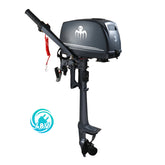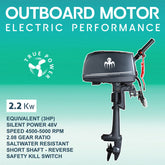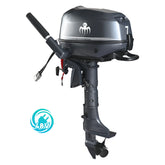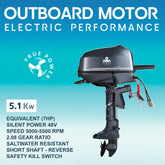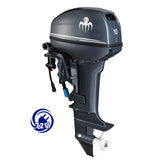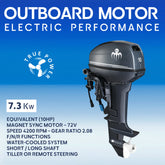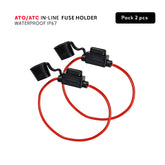Direct Drive vs Geared Electric Outboard Motors
Direct Drive vs Geared Electric Outboard Motors
The rise of electric outboards has transformed boating, offering clean, quiet, and efficient propulsion. But not all electric motors are built the same. One of the most important distinctions is between direct drive and geared drive systems. While both deliver electric propulsion, their behavior in real marine conditions can be very different.
Unlike cars, boats face constant drag, unpredictable loading, and the risk of striking submerged objects. Choosing between direct and geared drive is not just about efficiency on paper — it directly affects torque, range, noise, and long-term reliability.
How Each System Works

Direct Drive Electric Outboard
A direct drive outboard connects the motor shaft directly to the propeller. The prop spins at the same rpm as the motor rotor. With very few moving parts, direct drive designs are ultra-quiet and low-maintenance. However, because there is no gear reduction, the motor must generate high torque at low rpm. This increases amp draw, cabling size, and battery stress.
Geared Electric Outboard
A geared outboard uses a planetary or bevel gear to reduce propeller speed relative to motor speed. The motor can spin faster (where brushless DC designs are most efficient), while the gear ratio multiplies torque at the propeller shaft. Prop speeds of 2200–2500 rpm are typical, which closely matches the feel of small petrol outboards.
Comparison Table: Direct Drive vs Geared Electric Outboard
| Feature | Direct Drive Outboard Motor | Geared Outboard Motor |
|---|---|---|
| Noise | Near silent, only motor hum in water. | Slight gear whine, but far quieter than petrol. |
| Low-Speed Torque | Limited. Requires more current and larger motor to push loads. | Excellent. Gear multiplies torque for strong thrust and acceleration. |
| Energy Consumption | No gear loss, but higher amp draw = more heat loss. | 5–8% gear loss, but lower current peaks = better range under load. |
| Cabling & Battery Stress | High current requires heavy cables and stresses batteries. | Lower current demand, lighter cabling, cooler operation. |
| Impact Resistance | Motor pod acts as skeg. Impacts can damage the motor. | Lower unit is sacrificial. Props, seals, gears replaceable. |
| Maintenance | Minimal. No gears or oil to change. | Periodic gear oil change and seal inspection. |
| Durability & Repair | If flooded or hit, replacement is costly. | Uses standard marine parts. Serviceable by technicians. |
| High-Speed Efficiency | Very efficient at flat-water cruising speeds. | Slight gear loss, but allows larger and more efficient props. |
| Performance in Chop / Load | Efficiency drops under heavy load; current spikes. | Consistent torque across varying sea states and loading. |
| Spare Parts | Proprietary. Replacement may require full unit swap. | Standardized props, seals, anodes widely available. |
| Regeneration | Possible. Useful for sailing (hydro-generation). | Not practical (clutch prevents reverse spin). |
Noise & Comfort
One of the biggest selling points of direct drive is noise — or rather, the lack of it. With no gears, these motors are virtually silent, making them ideal for wildlife observation, lake fishing, or sailing. Geared units do produce some gear whine, but it is minimal and still far quieter than any petrol engine. For many boaters, the difference is barely noticeable once underway.
Battery & Installation Impact
In calm water and steady cruising, direct drive outboards are more efficient because there are no gear losses, but they depend on higher current at low rpm to deliver thrust, which increases cabling and battery demands when the boat meets resistance. By contrast, geared outboards keep the motor spinning in its efficient range, with the reduction multiplying torque at the propeller — so in choppy water, through seaweed, mud, or under heavy loads, they avoid excessive current spikes, reduce battery strain, and deliver more consistent runtime.
Not Just a Trolling Motor in Disguise
Many offerings on the market today are essentially trolling motors disguised as outboards. They use lightweight pods, direct drive motors, and plastic propellers, often covered by a casing shaped like a rudder to mimic the look of a true outboard. While fine for calm lakes, they fall short in tougher marine conditions. When a plastic prop strikes debris, it often cracks — and replacements are locked to proprietary designs, limiting flexibility and driving up cost.
Baywatt takes a different approach. Our outboards are built as true blue water motors, designed for real marine use. We use metal propellers, not plastic. If one bends on impact, it can be easily replaced with any standard aftermarket marine prop. This keeps Baywatt motors practical, serviceable, and reliable in ways that many lightweight electrics cannot match.
Baywatt Outboards – A Blue Ocean Approach
Baywatt OBE-series electric outboards (2.2 kW ≈ 3 HP and 5.1 kW ≈ 7 HP) are built with geared architecture because it delivers the best balance of thrust, efficiency, and durability. By combining a brushless DC motor with a 2.08:1 gear reduction, Baywatt achieves prop speeds around 2200–2400 rpm, matching the performance of small petrol outboards. This provides the torque needed to move heavier boats, handle chop, and maneuver confidently at the dock.
For professional operators, it’s true that some direct-drive frames are lighter to lift and carry — convenient for fleets and rental use. But Baywatt prioritizes robustness and serviceability. With a classic outboard lower unit, common parts like seals, gears, and props are easy to replace without scrapping the entire motor.
When to Choose Each Type
Choose a Geared Electric Outboard if…
- You often carry passengers or heavy loads (push or tow a sailboat)
- You navigate rocky or shallow waters where impacts are likely to happen often.
- You want serviceability with widely available spare parts.
- You need consistent thrust in chop, current, or towing situations.
Choose a Direct Drive Electric Outboard if…
- You operate mostly on flat, calm water at steady speed.
- You prioritize silence above all else.
- You want something light and easy to carry.
- You don't want to service it anymore.
Conclusion
Both direct drive and geared electric outboards have their place. Direct drive units are unmatched for silence, simplicity, and light cruising. Geared units, however, deliver higher torque, better acceleration, easier repair, and more versatile performance when conditions are tougher.
For many boaters transitioning from petrol, Baywatt outboards represent a balanced “blue ocean” solution — combining the efficiency of electric drive with the durability and practicality of a true marine outboard.
